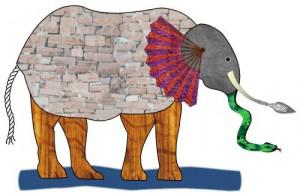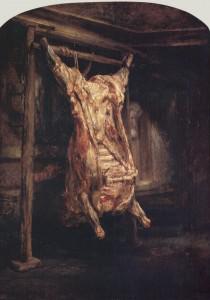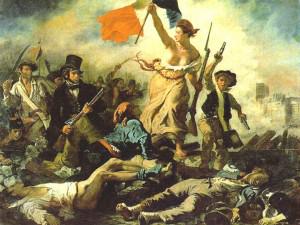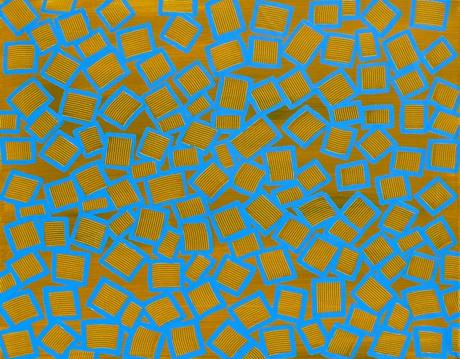In case your one of the billions of people in this amazing world that do not understand, here’s the centuries old scoop. No two people look at a piece of art the same way. In fact, no two people look at much of anything in the same way. We can agree that an elephant is by definition an elephant, but that’s where it quickly ends. One may see one of God’s great achievements, another may see a bountiful meal that could sustain a tribe for weeks.
OR…
“Three Blind Men and an Elephant”
One day, three blind men happened to meet each other and gossiped a long time about many things. Suddenly one of them recalled, ” I heard that an elephant is a queer animal. Too bad we’re blind and can’t see it.”
“Ah, yes, truly too bad we don’t have the good fortune to see the strange animal,” another one sighed.
The third one, quite annoyed, joined in and said, “See? Forget it! Just to feel it would be great.”
“Well, that’s true. If only there were some way of touching the elephant, we’d be able to know,” they all agreed.
It so happened that a merchant with a herd of elephants was passing, and overheard their conversation. “You fellows, do you really want to feel an elephant? Then follow me; I will show you,” he said.
The three men were surprised and happy. Taking one another’s hand, they quickly formed a line and followed while the merchant led the way. Each one began to contemplate how he would feel the animal, and tried to figure how he would form an image.
After reaching their destination, the merchant asked them to sit on the ground to wait. In a few minutes he led the first blind man to feel the elephant. With outstretched hand, he touched first the left foreleg and then the right. After that he felt the two legs from the top to the bottom, and with a beaming face, turned to say, “So, the queer animal is just like that.” Then he slowly returned to the group.
Thereupon the second blind man was led to the rear of the elephant. He touched the tail which wagged a few times, and he exclaimed with satisfaction, “Ha! Truly a queer animal! Truly odd! I know now. I know.” He hurriedly stepped aside.
The third blind man’s turn came, and he touched the elephant’s trunk which moved back and forth turning and twisting and he thought, “That’s it! I’ve learned.”
The three blind men thanked the merchant and went their way. Each one was secretly excited over the experience and had a lot to say, yet all walked rapidly without saying a word.
“Let’s sit down and have a discussion about this queer animal,” the second blind man said, breaking the silence.
“A very good idea. Very good.” the other two agreed for they also had this in mind.
Without waiting for anyone to be properly seated, the second one blurted out, “This queer animal is like our straw fans swinging back and forth to give us a breeze. However, it’s not so big or well made. The main portion is rather wispy.”
“No, no!” the first blind man shouted in disagreement. “This queer animal resembles two big trees without any branches.”
“You’re both wrong.” the third man replied. “This queer animal is similar to a snake; it’s long and round, and very strong.”
How they argued! Each one insisted that he alone was correct. Of course, there was no conclusion for not one had thoroughly examined the whole elephant. How can anyone describe the whole until he has learned the total of the parts.

The Fable of the Elephant & the Blind Men
Perception is the mother of everyone’s reality. Just the word ART alone can set off unusual brain waves and patterns when viewed with an MRI.
A humble two-dimensional painting gives the viewer very little. You can’t hear it, you can’t taste it, and if it’s dry…you can’t even smell it. “Although we should get a flash mob together and go to the Louvre in Paris and simultaneously start smelling the works of Rembrandt. Most specifically The Carcass of Ox painting.”

Rembrandts - The Carcass Ox - Louvre Paris
Click to enlarge the carcass.
Not so pleasant huh?
Let’s say that 50 people show up…some art students, some vacationers, a couple of anarchists – who always show up for anything, perhaps a few stragglers from a tourist group and just for the sake of overall continuity one art critic.
Each one will look at this painting and interpret it entirely different from the other. If there is a consensus it might be…”What the hell was Rembrandt thinking when he painted this?” After that the opinions are going to be quite varied. The art students will quickly say, “Oh I read about this painting. I didn’t like it then, and I don’t think I like it now. But what use of painting technique.” The vacationers, ” Well I’m glad we got to visit the world famous Louvre and participate in the Flash Mob. Don’t know about this painting. What are we having for lunch anyway.” The anarchists -Without rule, they may interpret the painting as a metaphor for filleting society. The stragglers from the tourist group will first take a picture and they will discuss the merits of this painting each with a decidedly less than articulated interpretation and view. The art critic first he will say, “ This painting truly describes the human condition and should remind everyone why it’s better to become a vegetarian.” And then go on to say, “This painting fits into a less meaningful period of the artist’s life.”
The influence of art on the viewer…
Comments like…I love red. So every painting that has red in it excites me. I like pastoral scenes. Every painting that calms my inner spirit is great. Some better than others. I am into jazz. Paintings that are abstract really turn me on. They just seem to have a rhythm to them. Especially if there’s lots of shades of yellow. Historical paintings really turn me on especially Delacroix’s Leading the People that inspired the Statue of Liberty 50 years later.

Delacroix - Leading the People
So let’s take the pastoral painting by Alvan Fisher 1854 for example:

Alvan Fisher Pastoral Landscape
Each viewer who gazes upon this painting is going to be influenced by his/her own historical references and every or many experiences they have had in life. If you grew up on a (old style) farm you will be able to really relate because of the livestock and the pond. Others will think of the sounds of nature and the stillness of the trees, maybe even humming Bach’s Jesu Bleibet Freude. Some will completely immerse in the color palette, so many different shades of earth tones. And those who are into light will relish in the warmth and glow of the late afternoon sun as it inflames the foothills of the mountain.
No two artists paint nearly the same…and for sure…no two art viewers see art in the same way. Even though they have the gift of vision to see the painting, they are still blinded by a brain filled with memories. It takes a tremendous amount of effort, and I might say…courage…to empty your brain and really see a painting for the first time. Go and visit a favorite painting once a month at a museum. Do this for an entire year and note the changes of your interpretations. You will be absolutely astonished when you go back and read your notes.
They Will Never See What You See…
As artists we expect so much of those who look at our work. What we see is “OUR REALITY” and not those of our viewers. When someone likes a piece of our work we should never expect that they are being excited by anything we did in its creation. It’s really more about their life and their experiences, and what they bring to the visual table.

Rod Jones Artist - Algernon - Oil on Canvas
View this painting full screen. I have heard so many interpretations. The most fascinating is the fact that some people only focus on the blue squares. Others see the backgrounds shapes more prominently. It’s not an optical illusion. It’s just a perception and how your subconscious mind in conjunction with your vision can interpret a relatively simple piece of art work. An no…it is not a close-up of the wall of the elephant.

